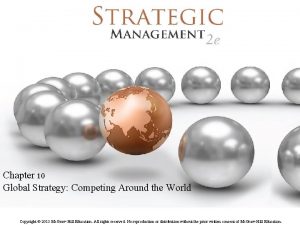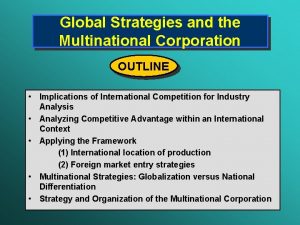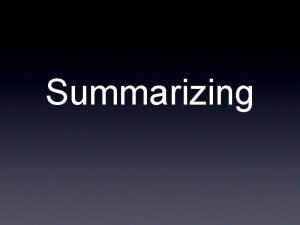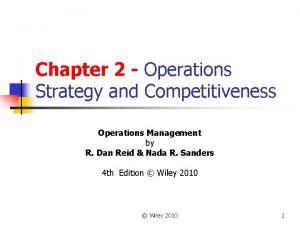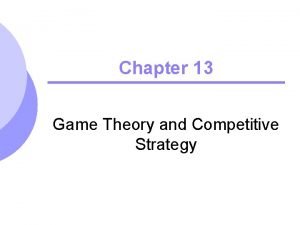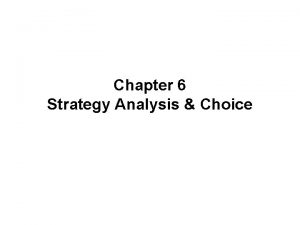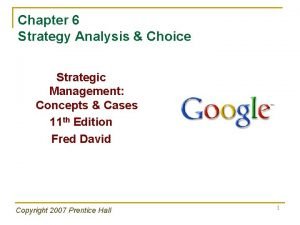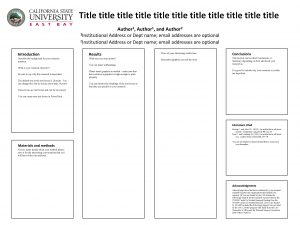What Is Strategy and Why Chapter Is Title




















- Slides: 20

What Is Strategy and Why Chapter Is Title It Important? Mc. Graw-Hill/Irwin Copyright © 2008 by The Mc. Graw-Hill Companies, Inc. All rights reserved.

“Without a strategy the organization is like a ship without a rudder. ” Joel Ross and Michael Kami

Thinking Strategically: The Three Big Strategic Questions 1. What’s the company’s present situation? 2. Where does the company need to go from here? 3. How should it get there? – A company’s answer to “how will we get there? ” is its strategy

What Do We Mean By “Strategy”? • Consists of competitive moves and business approaches used by managers to run the company • Management’s “action plan” to – Grow the business – Attract and please customers – Compete successfully – Conduct operations – Achieve target levels of organizational performance

Key Elements of a Successful Strategy • Developing a successful strategy hinges on making competitive moves aimed at – Appealing to buyers in ways to set the enterprise apart from rivals and – Carving out its own market position • Involves developing a distinctive “aha” element to – Attract customers and – Produce a competitive edge Copying competitive moves of other successful companies rarely works!

A Powerful Strategy Leads to Sustainable Competitive Advantage • A company achieves sustainable competitive advantage when an attractive number or buyers prefer its products/services over those of rivals and when the basis for this preference can be maintained over time What separates a powerful strategy from an ordinary strategy is management’s ability to forge a series of moves, both in the marketplace and internally, that produces sustainable competitive advantage!

Four “Best” Strategic Approaches to Building Sustainable Competitive Advantage • • Being the industry’s low-cost provider Incorporate differentiating features Focusing on a narrow market niche Developing expertise and resource strengths not easily imitated or matched by rivals

Competitive Advantage Examples • Strive to be the industry’s low-cost provider – Wal-Mart – Southwest Airlines • Outcompete rivals on a key differentiating feature – – – Johnson & Johnson – Reliability in baby products Harley-Davidson – King-of-the-road styling Rolex – Top-of-the-line prestige Mercedes-Benz – Engineering design and performance L. L. Bean – Good value Amazon. com – Wide selection and convenience

Competitive Advantage Examples (cont) • Focus on a narrow market niche – – – e. Bay – Online auctions Jiffy Lube International – Quick oil changes Mc. Afee – Virus protection auctions Starbucks – Premium coffees and coffee drinks The Weather Channel – Cable TV • Develop expertise, resource strengths, and capabilities not easily imitated by rivals – – Fed. Ex – Next-day delivery of small packages Walt Disney – Theme park management and family entertainment Toyota – Sophisticated production system Ritz-Carlton – Personalized customer service

Fig. 1. 1: Identifying a Company’s Strategy

Why Do Strategies Evolve? • A company’s strategy is a work in progress • Changes may be necessary to react to – Shifting market conditions – Technological breakthroughs – Fresh moves of competitors – Evolving customer preferences – Emerging market opportunities – New ideas to improve strategy – Crisis situations

Fig. 1. 2: A Company’s Strategy Is Partly Proactive and Partly Reactive

A Firm’s Ethical Responsibilities to Its Stakeholders Owners/shareholders – Rightfully expect some form of return on their investment Employees - Rightfully expect to be treated with dignity and respect for devoting their energies to the enterprise Customers - Rightfully expect a seller to provide them with a reliable, safe product or service Suppliers - Rightfully expect to have an equitable relationship with firms they supply and be treated fairly Community - Rightfully expect businesses to be good citizens in their community

What Is a Business Model? • A business model addresses “How do we make money in this business? ” • Do the revenue-cost-profit economics of the strategy make good business sense? – Look at revenue streams the strategy is expected to produce – Look at associated cost structure and potential profit margins – Do resulting earnings streams and ROI indicate the strategy makes sense and the company has a viable business model for making money?

Relationship Between Strategy and Business Model Strategy. . . Deals with a company’s competitive initiatives and business approaches S gy e t tra ss ine el s Bu od M Business Model. . . Concerns whether revenues and costs flowing from the strategy demonstrate a business can be amply profitable and viable

Microsoft’s Business Model Employ a cadre of highly skilled programmers to develop proprietary code; keep source code hidden from users Sell resulting OS and software packages to PC makers and users at relatively attractive prices to achieve a 90% or more market share Most costs in developing software fixed; variable costs are small; once break-even volume is reached, revenues from additional sales are almost pure profit Provide modest level of technical support to users at no cost Rejuvenate revenues by periodically introducing next-generation software with features inducing PC users to upgrade their operating systems

Red Hat’s Business Model Rely on collaborative efforts of volunteer programmers to create the software Collect and test enhancements and new applications submitted by volunteer programmers for evaluation and inclusion in new releases of Linux Market upgraded and tested family of Red Hat products to large companies, charging a subscription fee that includes 24/7 support within 1 hour in 7 languages Make source code open and available to all users Capitalize on specialized expertise required to use Linux by providing fee-based training, consulting, software customization, and client-directed engineering to Linux users

Your Opinion Who has the best business model – Microsoft or Red Hat? Financial Comparison

Tests of a Winning Strategy • GOODNESS OF FIT TEST – How well does strategy fit the firm’s situation? • COMPETITIVE ADVANTAGE TEST – Does strategy lead to sustainable competitive advantage? • PERFORMANCE TEST – Does strategy boost firm performance?

Robin Hood Prince of Thieves What is Robin Hood’s Business Model?
 Andreas carlsson bye bye bye
Andreas carlsson bye bye bye Title fly and title page
Title fly and title page Dont ask why why why
Dont ask why why why Title title
Title title Corporate strategy vs business strategy
Corporate strategy vs business strategy Example of aggregate planning
Example of aggregate planning Multi domestic strategy
Multi domestic strategy Multidomestic company
Multidomestic company Aligning hr strategy with business strategy
Aligning hr strategy with business strategy Integration responsiveness grid
Integration responsiveness grid The managerial process of crafting and executing strategy
The managerial process of crafting and executing strategy Globalization strategy
Globalization strategy Bottom-up listening strategies examples
Bottom-up listening strategies examples Directional strategy in strategic management
Directional strategy in strategic management Multinational strategy vs global strategy
Multinational strategy vs global strategy When should we teach students to summarize as they read
When should we teach students to summarize as they read Chapter 2 operations strategy and competitiveness
Chapter 2 operations strategy and competitiveness Competitive operations strategy
Competitive operations strategy Chapter 13 game theory and competitive strategy
Chapter 13 game theory and competitive strategy Chapter 6 strategy analysis and choice
Chapter 6 strategy analysis and choice Strategy analysis and choice
Strategy analysis and choice









